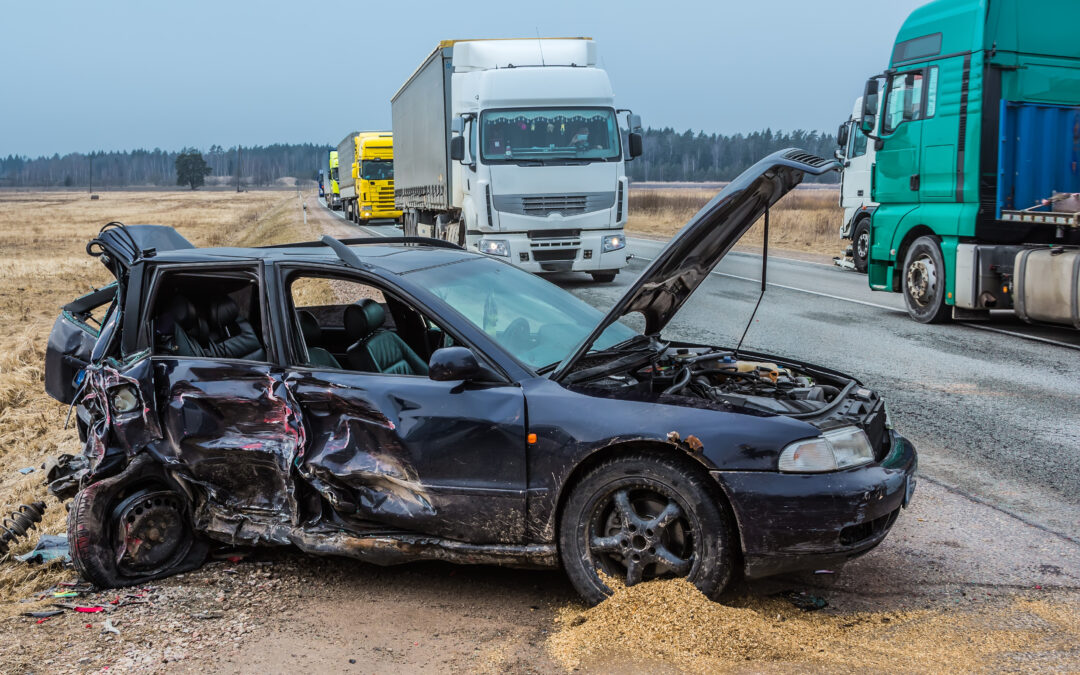ACCIDENTS INVOLVING COMMERCIAL VEHICLES
Due to the disproportionate size and weight of commercial vehicles (semi-trucks) and the corresponding likelihood of resulting injuries, commercial drivers and trucking companies must exercise great caution. Simple physics dictate that the greater mass and weight of a commercial vehicle will increase the force inflicted on a smaller passenger vehicle.
For this reason, various state and federal laws are in place to protect the safety of the traveling public. For example, the amount of driving time is regulated by federal laws to ensure that commercial drivers are not impaired by fatigue. Trucking Companies are also required to complete periodic maintenance and inspections of the truck and trailer combinations and maintain records of the maintenance and safety checks conducted. Most states (including Minnesota) have a commercial vehicle inspection department to investigate the safety equipment of commercial vehicles involved in serious collisions. It is common that post-collision inspections reveal, for example, defective trailer brakes, which may have prevented the commercial vehicle from stopping properly.
10 STEPS TO TAKE AFTER A TRUCK OR COMMERCIAL VEHICLE ACCIDENT
If you are involved in a collision with a commercial vehicle, you must act to ensure that you get the medical attention you need as well as be fully compensated for your out-of-pocket expenses as well as non-financial damages. Here are ten steps to take after being involved in a commercial vehicle accident.
1. Get to safety (if possible)
No matter how severe the accident is, you should stop your vehicle and if possible, move off the traveled portion of the roadway. Remaining in the middle of the road or on the pathway of other vehicles is dangerous. Secondary collisions are common, particularly on icy or snow-packed conditions. Protect yourself.
2. Call 911
The danger of secondary collisions is greatly decreased once law enforcement arrives. Approaching vehicles may have no notice of the accident ahead until law enforcement can take control of the scene.
3. Check the accident scene for other injured persons
Even if you and your passengers appear to be fine, you should look for others who might be hurt and require emergency care.
4. Check your vehicle and the commercial vehicle for hazards
Sometimes, your car may be leaking or catch fire, and in other cases, debris on the roadway might require oncoming motorists to swerve. Remain calm and assess where the next hazard may develop.
5. Call the police (even if you were not injured)
In Minnesota, drivers are required to report accidents that involve fatalities, injuries, or significant property damage. A collision report may include helpful information that can be submitted as evidence, such as witness statements, the officer’s opinion concerning fault, and a sketch of the scene.
6. Take photos if you can safely do so
Photographs of the scene, the vehicles involved in the collision, and your injuries (before and after treatment) can be used as evidence later. If weather or road conditions played a part in causing the crash, they can also be very valuable as these conditions can change.
7. Exchange information with the CMV driver
You should obtain the other driver’s name, contact information, insurer, address, truck carrier company name, and truck number. Take photos of both the cab and trailer including license plates, as frequently, the cab and trailer are owned by separate entities, and may be separately insured.
8. Obtain any witness contact information
You should also ask for the contact information of witnesses, as these details can be important. Witnesses are not required to wait for law enforcement, so identifying witnesses before they leave may prove essential.
9. Get medical treatment
Being looked over by EMTs or medical staff can help ensure you get the medical care and treatment you need. If injured, your medical treatment is the only record available to document the symptoms you experienced after the collision. The longer you wait, the more difficult it will be for your treating physicians to relate your symptoms to the collision. Remember, an injured person must prove that the injuries complained of are the result of the collision, as opposed to other possible causes. Get treated early, so you have a clear medical history that the symptoms arose immediately after the collision. Your doctor may also advise you of the potential symptoms you may develop later that can signal a more serious injury (like a compressed spinal nerve which can lead to slowly increasing numbness or weakness). If offered advanced imaging, take it. You should always adhere to your doctor’s treatment plan, including follow-up visits. If you cease treating, your physician will assume your injuries have resolved.
10. Talk to a commercial vehicle accident attorney
Before you speak with the insurance company, contact an experienced personal injury attorney. This step is one of the most important parts of the post-accident procedures. While many people consider forgoing hiring an attorney, that can be a huge mistake, as you are at the mercy of claims professionals who have no loyalty to you. We have handled thousands of cases successfully, and we can act as advocates for you by working to ensure you are fully and fairly compensated. Oftentimes, insurance companies offer collision victims lowball settlement offers. However, once retained, we can fight for your right to fair compensation and be the point of contact for both your insurer and the other party’s insurer.
If you have recently been involved in a commercial vehicle (semi or 18- wheeler) accident and live in the greater Buffalo, MN area, contact Kiernan Personal Injury Attorneys for a free consultation today. We can speak with you at your home, in our office, or remotely to assess your situation and determine your best legal options. There’s no risk, no obligation, and you pay nothing unless we recover for you.
